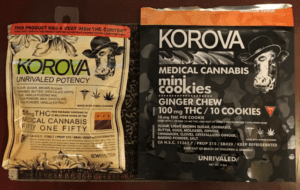With the turn of the new year, California’s cannabis market has undergone massive changes. As adult-use sales for cannabis begin, the industry is transitioning from following loose, unregulated practices to following a strict set of state regulatory demands set by the Bureau of Cannabis Control.
So far in BDS Analytics’ man-on-the-street project of visiting and contacting as many dispensaries as possible during this transition to adult-use sales, we have seen how very few of California’s roughly 1,100 storefronts and 2,000 delivery services are fully compliant under the emergency regulations issued by the BCC. Mostly that’s down to local regulators not getting adult-sale permits issued, leaving the lion’s share of dispensaries in the medical-only market.
But those operating with adult-sale permits face their own challenges. One aspect of the emergency regulations that is particularly confusing regards the new 100mg THC limit for edibles.
Many retail stores still have high potency products on the shelves, available only to those with a doctor’s recommendation; but suddenly they are dealing with an influx of customers without cards. This lingering stock of potent products has led to confusion among consumers, with some adult-use customers not pleased they can’t buy them, and some medical patients worrying if the potent pain-relieving products they need will be available in the new market.
Many retailers also appeared to still be getting their heads around the emergency regulations as adult-use sales rolled out. At the first store I visited on Monday, my budtender denied my request for a high-dose edible with a quick “sorry not without your rec, man.” At a different store their staff were not as well versed, and my purchase of a 1000mg brownie was only thwarted when the point of sale system informed my budtender that the purchase was not allowed.
Confusion extends beyond that of a few budtenders. One dispensary incorrectly interpreted the 100mg limit as applying to each customer’s purchase, rather than just a 100mg THC limit per product. On the first day of adult-use sales, this particular store only allowed one edible per sale for each customer. Though this regulation was clarified in the afternoon, you can imagine how much money was left on the table by this opening-day misfire.
The challenge is that in the medical-only market in which virtually all customers were heavy consumers of cannabis, many edible companies that have successfully built a brand in California’s medical market did so by marketing the high potency of their products. Hence a company that has built a brand on high-potency products has to worry about staying relevant when their most popular products are not available to the vast majority of the dramatically expanded customer base.
BDS Analytics’ retail tracking data shows 81% of California’s 2017 cannabis edible market consisted of products containing more than 100mg THC. The high popularity and sheer volume of sales of these products show that this concern about potency limit does not just affect a few companies, but rather the majority of the producers, and every single retailer who will be transitioning from the old medical-only market.



